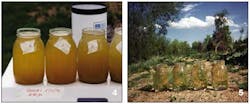Grant Ranch Stormwater-Quality Management Program
In the mid-1990s, the proposed Grant Ranch residential development in Littleton (a suburb of Denver), CO, raised concerns with the residents of Bow Mar over potential adverse impacts to Bow Mar Lake. Approximately 77 ac. of the Grant Ranch development, in fact, are tributary to Bow Mar Lake, which has a long history of use by Bow Mar residents for swimming, fishing, watching wildlife, and other activities, and the lake is a significant visual amenity that enhances property values. To address residents’ concerns, such as increased sediment loading, accelerated eutrophication, increased bacterial concentrations, and visual impairment, the developer, the metropolitan district, representatives of the Bow Mar neighborhood, and technical consultants and attorneys from both sides negotiated a comprehensive stormwater agreement, dated March 1997.
This article describes the highly effective stormwater-quality management program stimulated by the 1997 agreement. Performance data for the past three and a half years, based on five fully automated monitoring stations and including both dry-weather and wet-weather events, are summarized. The program employs a broad mixture of nonstructural and structural best management practices (BMPs). Nonstructural BMPs include covenants that homeowners have signed and implemented, regular community education, and limitations on fertilizer and pesticide use. Structural BMPs include three extended dry detention basins (EDBs) that drain into a combination volume [WQCV, as defined by the American Society of Civil Engineers (ASCE) and the Water Environment Federation (WEF), 1998] over more than 40 hours, which is a major factor in its exceptional performance.
The stormwater agreement imposed many requirements on the developer and the metropolitan district, including numeric limits on both dry-weather and wet-weather discharges for a broad array of pollutants. The agreement specifies provisions that must be followed if the specified numeric thresholds are not met.
Figure 1 is a map of the location. Photographs 1, 2, and 3 show one of the EDBs and the wetland/retention pond.
1997 Comprehensive Stormwater Agreement
Tables 1 and 2 describe the numeric criteria, termed thresholds, that were established for the stormwater system. Based on state and federal water-quality criteria and standards, performance studies of other treatment systems in the Denver metropolitan area, values from national literature, interviews with BMP experts, and engineering judgment, these thresholds were the subject of much discussion and debate among the various engineers and scientists who helped to negotiate the agreement. Key elements related to the success of the agreement include built-in flexibility to revise the thresholds as data become available, a good working relationship between all parties to the agreement, and prompt responses to observed problems to ensure that the BMPs are functioning as designed. For certain constituents lacking performance data, all parties agreed to defer identification of thresholds until two to three years of monitoring data were available to provide a rational basis for the limits.
The agreement specifies that if the running average of the four most recent samples exceeds the thresholds in Tables 1 and 2, the metropolitan district must promptly ascertain why the desired performance is not being met and must implement suitable mitigation or maintenance measures.
Construction-Phase BMPs and Monitoring
During construction, the developer was required to meet a total settleable solids limit of 2.5 ml/l/hr. (as measured by an Imhoff Cone) at the downstream property line. This limitation was met by capturing runoff in sedimentation basins large enough to store approximately the total 10-year runoff volume. The sedimentation basins discharged through a perforated pipe diffuser into a meadow, where additional treatment occurred via overland flow over a distance of 300–400 ft. The performance of the treatment system during construction was excellent, with only one exceedance of the numeric limit during a time span of about three years, based on analysis of about 50 samples.
Postconstruction (Urbanized Condition) BMP Implementation and Monitoring
Consistent with recommendations by such organizations as EPA, ASCE, WEF, and numerous municipalities, a multilayered “treatment-train”approach was used at Grant Ranch. The structural BMPs within the treatment train include the three EDBs, which discharge to a combination wetland/retention pond, as shown in Figure 1, before discharge to Bow Mar Lake. These BMPs were designed according to criteria in the 1992 Urban Drainage and Flood Control District (UDFCD) Urban Storm Drainage Criteria Manual. Each of these storage facilities is configured with a multistage outlet to provide treatment of the WQCV and reduction of 10- and 100-year peak flows to historic levels. The WQCV is based on roughly the 80th percentile runoff event on an average annual basis, according to WEF and ASCE (1998) and UDFCD (1992 and 1999). As mentioned, each EDB was designed to drain the WQCV over a 40-hour period, and the wetland/retention pond provides an additional 24 hours of residence time for the full WQCV. UDFCD funded a retrofit to the one of the EDBs in 2001 to evaluate the performance of new (1999) drainage criteria, which focused on a new outlet design, and has been monitoring inflows and outflows at this facility ever since (Gavin and Doerfer, 2001).
The wetland/retention pond has three separate cells and was vegetated in accordance with a formal planting plan that featured a mixture of wetland plants, including spiked rush, Baltic rush, Torrey’s rush, and sedges. Riparian shrubs were also planted, and cattails grew in on their own. As shown in Photographs 2 and 3, plant growth has been exceptional, and the facility has good visual appeal, which is important for adjoining homeowners, and also attracts wildlife.
All of the storage facilities were designed with public safety and maintenance in mind. For example, the outlet structures have safety/trash racks and mild sideslopes (see Photograph 1), and the facilities are regularly maintained and can be easily accessed. Creation of mosquito habitats was an additional concern, although this is mitigated because the EDBs do not typically store water for more than two to three days, and water is constantly moving through the wetland/retention pond as shown by diurnal water-surface fluctuation, which is magnified during rainfall events.
The 1997 agreement requires monitoring of four storm events and four base-flow samples each year. Flow-weighted composite storm-flow samples are collected from the inlets to the EDBs and from the outlet of the wetland/retention pond using automated Isco Model 3700 samplers and Model 4250 flow meters, which are monitored remotely via modem. Tipping-bucket rain gauges collect precipitation data at each of the EDBs, and UDFCD is monitoring inflows/outflows at one of the EDBs to isolate its performance from the overall system. In practice, fewer than four wet-weather events have been successfully sampled each year due primarily to failure to collect representative samples from all locations throughout the system.
Nonstructural BMPS
Various nonstructural BMPs (source controls) complement the structural BMPs described above and include:
- covenants that homeowners must sign and agree to abide by, regarding such topics as pet control and pet waste, materials storage, materials disposal, chemical use, and limitations on fertilizer and herbicide use;
- regular community education;
- strict limitations on fertilizer and pesticide use in common areas, which are maintained by an outside service;
- limitations on the use of sand, salt, and other deicing agents on roads in the winter;
- vegetation-management practices.
Community residents and outside-maintenance companies actively respond to requests to minimize activities that could negatively affect Bow Mar Lake. For example, the quality of inflows to EDBs has been used to roughly indicate the effectiveness of nonstructural BMPs, and in one instance when relatively high levels of nitrogen and phosphorus were observed in runoff from the development, neighborhood residents were asked (at a meeting and via a flyer which was sent to each home) to reduce fertilizer use. The available data do not enable a rigorous quantitative assessment of the effectiveness of this request, although anecdotal evidence and subsequent monitoring data suggest that residents were responsive.
System Performance
Per the 1997 agreement, monitoring is restricted to storm events that generate up to 0.5 in. of precipitation, which corresponds to the 80th percentile event for the region. Larger storms have been sampled for diagnostic purposes, and results have been consistent with those observed for “required” storms.
Based on more than three years of monitoring data, performance of the Grant Ranch stormwater system has been excellent. Tables 3 and 4 summarize performance data. For example, during wet-weather events, 67% of all event mean concentrations (EMCs, or flow-weighted pollutant concentrations) for total suspended solids (TSS) are less than 10 mg/l, and 78% of all effluent EMCs are less than 15 mg/l. According to USEPA (1999) and the Center for Watershed Protection (2000), the lower limit of TSS without advanced treatment has been suggested as 10′ 20 mg/l. From a percent-removal perspective, the system consistently shows TSS mass-removal efficiencies of 90–95% for individual events. System performance is typified by the difference in appearance of storm inflow and discharge samples, shown in Photographs 4 and 5, respectively. (The cloudiness of the inflow samples is attributable to a few lots that were under construction when the photos were taken.)
Table 3 shows that the long-term median, wet-weather, total phosphorus concentration in discharges is 0.12 mg/l, while the long-term total nitrogen median concentration is 3.10 mg/l. When these outflow concentrations are compared to average inflow concentrations (0.57 mg/l for total phosphorus and 5.40 mg/l for total nitrogen), it is clear that significant nutrient removal is occurring. The system has yet to exceed terms of the 1997 agreement for metals relative to either concentration (based on state numeric standards for Bow Mar Lake) or percent removal; thus, significant metals removal is evident.
5. Corresponding outflow from wetland/retention basin
Testing of petroleum-related compounds and pesticides has not yielded any concentrations above the analysis-detection limits in more than three years of monitoring. Chloride concentrations are also well within terms of the agreement. Fecal coliform removal rates have been quite high, with typical removal rates of more than 95% for individual events. This is not surprising, given the extended system residence time.
Monitoring of base-flow water quality during dry weather shows that median phosphorus concentrations are below those reported by the Nationwide Urban Runoff Program for residential development (USEPA, 1983). Pesticides have rarely been detected, and fecal coliform concentrations do not appear to present a water-quality issue.
In most situations, BMP performance should account not only for observed pollutant removal but also for effective mitigation of adverse impacts to receiving stream/lake physical characteristics (such as stream-channel morphology) and biology. While not a provision of the 1997 agreement, flow monitoring of the BMP system indicates that substantial reductions in peak flow rates leaving the property are occurring. Bow Mar residents have not reported changes in the lake fishery since Grant Ranch was constructed, indicating that the BMP treatment train has helped preserve the biological integrity of Bow Mar Lake.
Authors’ Perspectives
Percent Removal
An important observation regarding the 1997 agreement and the performance thresholds is that BMP performance should not be expressed in terms of “percent removal”; instead, the focus should be on effluent concentrations because percent removal is strongly influenced by inflow concentration. For example, with an inflow TSS concentration of 500 mg/l, 80% removal is readily attainable. By contrast, if the TSS inflow concentration is 50 mg/l, 80% removal will likely not be feasible. With this in mind, one might wonder why percent removals were included as performance measures for some constituents in the 1997 agreement. Most published BMP performance assessments in 1997 focused on percent removals; hence, this was a reasonable metric to use. As more reliable and scientific performance data become available, such as via the ASCE/EPA International Stormwater BMP Database (www.bmpdatabase.org), it will be feasible to focus more on anticipated effluent quality and less on percent reductions.
Application of Numeric Thresholds
Another important observation is that although numeric thresholds (i.e., numeric limits) are a cornerstone of the 1997 agreement, we do not endorse widespread application of numeric limits for BMP discharges at this time. In the case of Grant Ranch, the owners of Bow Mar Lake insisted that numeric thresholds were necessary to ensure a very high level of stormwater treatment. In general, stormwater regulation is BMP-based rather than based on compliance with numeric discharge limits. There are many reasons for this, including – but not limited to – variability in runoff characteristics, BMP performance, and receiving-water characteristics, as well as the need for additional data regarding BMP performance and receiving-water impacts. Therefore, numeric discharge limits normally should not be applied to urban stormwater discharges. If numeric limits are unavoidable, readers are urged to obtain as much reliable and relevant BMP performance data as possible to provide a rationale for the limits. In addition, to increase the probability of complying with numeric limits, it is essential to utilize a multifaceted treatment-train approach with conservative design assumptions.
Conclusions
The Grant Ranch Stormwater Management Program demonstrates that carefully planned and designed nonstructural and structural BMPs, based on conservative design criteria and subject to regular monitoring and maintenance, can be quite effective at removing pollutants and, in the case of Bow Mar Lake, at protecting downstream receiving waters. Of course, adequate funding must underlie a program of this kind (for design, construction, monitoring, and maintenance). A substantial amount of money was spent by the parties to the 1997 agreement and continues to be spent by the metropolitan district on monitoring and maintenance.





